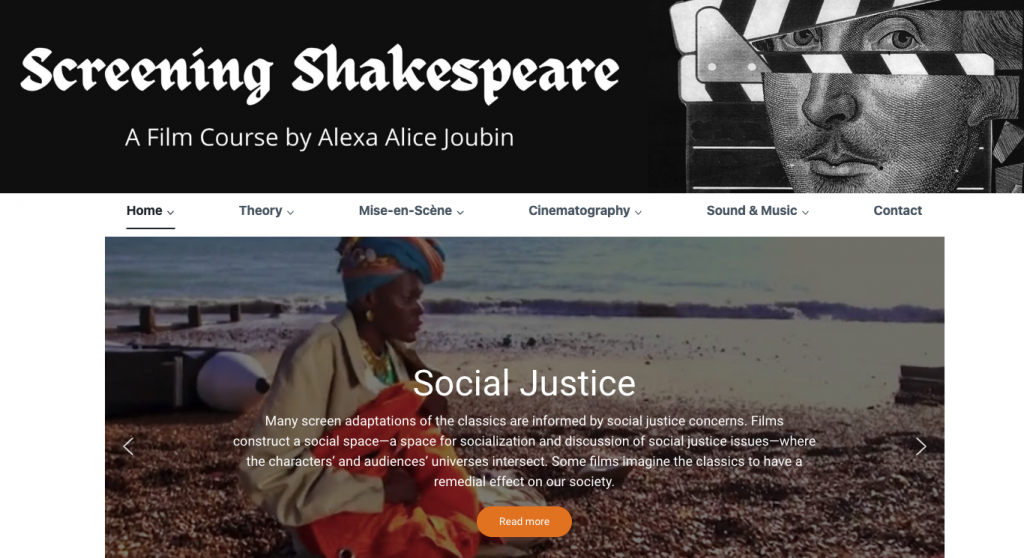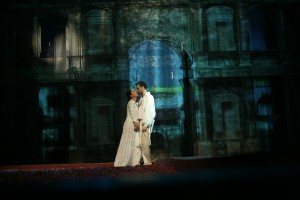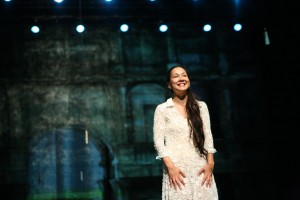About This Clip
Romeo and Juliet
ROMEO AND JULIET
Vera Komissarzhevskaya Theatre, St Petersburg, Russia
National Theatre Bitola, Macedonia
Director Dejan Projkovski
Review by Randall Martin
Last night the local mayor who had once played Hamlet in the state theatre inaugurated the first Bitola Shakespeare Festival. It opened grandly with a bilingual Macedonian and Russian production of Romeo and Juliet performed by the Vera Komissarzhevskaya Theatre, St Petersburg and the National Theatre Bitola.
The 850-seat theatre – the largest of the National Theatre’s stage spaces — shaped much of the production’s action and meaning. Opening to the frenetic rhythms of Prokofiev’s Romeo and Juliet, choreographed fighting between darkly dressed corps of Capulets and Montagues established an aesthetic of classical ballet or grand opera. This formality was matched by a huge multilevel Roman proscenium that filled the entire back wall of the stage. It recalled the 2nd-century Roman amphitheatre in nearby Heraclea Lyncestis, thus suggesting continuity between Bitola’s ancient dramatic heritage and its vibrant modern theatre culture.
At first I found that the vast playing space and highly wrought movements made it difficult to engage with emotions of the characters. But as the performance continued it seemed to me that director Dejan Projkovski was using the distancing effects of physical scale and conscious artistry strategically. As the classical proscenium also suggested, his production framed Shakespeare’s play as a tragedy of fate. The irreducibly conflicted circumstances of the lovers’ world ultimately dominates their efforts to transcend it through romantic love.
Romeo’s journey was accordingly one of existentially crushed rather than defiant aspirations. He began far differently from the self-absorbed melancholic of Shakespeare’s text. Nearly as cocky as Mercutio, Romeo needed little persuading to gate-crash the Capulet’s ball. The Queen Mab speech declared their shared need for constant physical and imaginative stimulation. Along with an equally laddish Benvolio, they mocked their hosts by mimicking a little tea party, pinkies foppishly extended, exchanging pleasantries in English accents. But afterwards Romeo read the tea leaves in his cup, momentarily shaken by the dark future they appeared to presage.
Juliet was also a departure from the bashful 13-yr old of traditional productions. She was delighted by her mother’s talk of marriage to Paris, girlishly excited to try on a fine wedding veil. In her well-mannered way she had absorbed the Nurse’s fantasies of marriage as a golden social and erotic opportunity. During the ball, danced to the ironic music of Prokofiev’s feud, Romeo appeared to transfer his affections from Rosaline to Juliet seamlessly. Yet later Rosaline appeared to speak an invented monologue which seemed to curse his betrayal. (I could only gather an impression because I don’t know the Russian spoken by the Capulets or the Macedonian spoken by the Montagues.)
When the lovers first encountered each other, Romeo was physically bold, even slightly aggressive, while Juliet’s interplay of hands seemed as eagerly exploratory as modestly shielding. At their parting she even stole a chaste kiss from him. For the balcony scene, Projkovski used the large space of the theatre to show the gulf between the feuding families being symbolically bridged. Juliet appeared at a window in the backstage proscenium, while Romeo lay on his back in the middle of stalls, spotlit, before advancing to the stage during his alternating monologues with Juliet. Then, addressing Romeo directly, she joined him at centre stage and took the lead physically and verbally in arranging their clandestine marriage.
In the consummation scene that followed Tybalt’s death and Romeo’s banishment, the lovers lay embraced at the centre-stage crossroads. Falling rose petals (later doubling as gouts of blood) were projected onto the proscenium as soft Prokofiev strings played in the background. For a few lovely minutes, lyricism competed with temporal and worldly ironies. But ultimately, I felt, the operatic aesthetic dwarfed the spoken expression of the moment, making it more aesthetically than emotionally engaging. The effect of distance again pointed towards Projkovski’s interpretation. Even in this most intimate of scenes, the lovers were always struggling to resist a star-crossing fate insistently expressing itself in stylized anticipations of death.
The effect on Romeo was to transform him from a young man of boundless self-confidence into a shattered lover. I thought he captured this change most sharply when he came to Friar Lawrence in despair after his banishment. Although Lawrence managed to thwart Romeo’s thoughts of suicide, it was the Nurse to whom he turned for real if temporary comfort. Like a hurt little boy, he clutched her skirts and allowed her to cradle him in the same way that she had soothed the distraught Juliet in the scene before.
But unlike Romeo, Juliet moved on from this moment. Her struggles were more authentically embodied, and spectators could feel her determined emotions because she connected directly with audience, above all in her moving soliloquy, ‘Gallop apace, ye fiery footed steeds.’ Speaking from the stage apron, she downsized the anticipated big aria. Her hopes and fears were persuasively nuanced because they came from within. When she was abused in turns by her brutal father and the sexually rapacious Paris, Juliet worked her body in beautifully supple ways to express both her inner distress and fierce resolve to seek her own way.
Both lovers’ journeys were partly redirected, however, by the production’s biggest change to Shakespeare’s script. A gloomy Friar Lawrence, appearing more burdened by life’s miseries than hopeful by his religion, gave Juliet the sleeping potion to allow her to avoid consummating marriage with Paris rather than to enable a complicated future reunion with Romeo. The business of misdirected letters and the apothecary was cut (or, our knowledge assumed), so that the action moved directly from Juliet’s funeral to the lovers’ final private encounter in the tomb. Overwhelmed by grief at the sight of Juliet’s apparently lifeless body, Romeo swallowed poison and collapsed disconsolate. Juliet woke up to match his sacrifice with one quiet thrust of her lover’s dagger as she lay stretched upon him. The relative restraint of this ending generated genuine emotional power. But in keeping with the production overall, its ambiguity as a sacrifice allowed the play’s wider conflicted world to prevail, as the grief-stricken Montagues and Capulets made only tentative gestures of reconciliation before a helpless Prince and silent Friar Lawrence.
Information courtesy of Professor Randall Martin, University of New Brunswick, Canada
2013 Bitola Shakespeare Festival
Russian and Macedonian co-production
BITOLA INTERNATIONAL SHAKESPEARE FESTIVAL
Bitola, Macedonia, 19-25 July 2013
Bitola’s National Theatre of Macedonia is boldly picking up where last year’s brilliant Globe-to-Globe Festival in London left off.
International festivals and local companies world-wide have long been reshaping Shakespeare as a multilingual and multicultural dramatic property. As part of the 2012 Cultural Olympiad, Globe-to-Globe took these ongoing experiments in intercultural exchange to a new level. Presenting Shakespeare’s 37 plays and non-dramatic poems in 40 languages over an eight-week programme, Globe-to-Globe launched an interactive paradigm for a planetary Shakespeare.
The Bitola Shakespeare Festival is making the next major contribution to this exciting venture. Between 19-26 July it will present eight Shakespeare plays and adaptations in seven languages by companies from Europe, Asia, and North America. The opening co-production of Romeo and Juliet by the National Theatre of Macedonia, Skopje, and the Vera Kommisazhevskaya Theatre, St Petersburg enhances the kind of artistic and cultural reciprocity which Globe-to-Globe modelled so successfully.
The closing production of Richard III by the National Theatre of China, Beijing, will give local audiences a chance to watch the critically acclaimed Globe-to-Globe production in a new setting: the 1st-century BC Roman amphitheatre in Heraclea Lycestis on the outskirts of Bitola. Spectators will also be able to see the much-anticipated classical Chinese costumes and properties that accidentally failed to reach Shakespeare’s Globe in time for last year’s performances. With them included, this year’s production will enrich the cultural dialogue between Asian and Western Shakespeares which NTC actors performed so enthrallingly in plain costumes on a bare stage.
The Festival will also reprise the Globe-to-Globe’s innovative and much-praised cycle of three Henry VI plays by the National Theatre of Serbia, Belgrade, Tirana’s National Theatre of Albania, and the National Theatre of Bitola. Having watched these plays last year before audiences made up partly of London’s Serbian, Albanian, and Macedonian communities, I am looking forward to seeing how audiences respond when they are staged before local audiences in Bitola, Macedonia’s second-largest city.
Performing Shakespeare in non-English languages raises fascinating questions of translation into contemporary verbal idioms and diverse visual and performance traditions. Festival audiences will be able to gauge the strengths and limits of Shakespeare’s openness to such appropriations in Taganka Theatre Moscow’s production of Twelfth Night, and in Nina Sallinen’s Finnish adaptation Poor, Poor Lear. Santa Barbara’s Lit Moon Theatre production of The Tempest will also explore the story and audience dynamics of an English postcolonial fable in a post-Soviet setting.
Romeo and Juliet
Interviews
New Books Network Interview: Shakespeare and East Asia
Shakespeare’s plays enjoy a great deal of popularity across the world, yet most of us study Shakespeare's local productions. Alexa Alice Joubin's Shakespeare and East Asia (Oxford 2021) addresses this gap through a wide-ranging analysis of stage and film adaptations related to Japan, South Korea, China, Singapore, Tibet, Hong Kong, and Taiwan. The New Books Network interview about the book by MIT Global Shakespeares co-founder Alexa Alice Joubin is now live. The interview was hosted by Amanda Kennell (North Carolina State University).more
Shakespeare’s plays enjoy a great deal of popularity across the world, yet most of us study Shakespeare’s local productions. Alexa Alice Joubin‘s Shakespeare and East Asia (Oxford 2021) addresses this gap through a wide-ranging analysis of stage and film adaptations related to Japan, South Korea, China, Singapore, Tibet, Hong Kong, and Taiwan.
The New Books Network interview about the book by MIT Global Shakespeares co-founder Alexa Alice Joubin is now live. The interview was hosted by Amanda Kennell (North Carolina State University).
The book focuses on post-1950 adaptations that were distributed across or associated with the Sinophone world and East Asia. She identifies a quartet of characteristics that distinguish these adaptations: innovations in form, the use of Shakespeare for social critiques, the questioning of gender roles, and the development of multilingual patterns of circulation.
The adaptations are alternately funny, dramatic, and thought-provoking, but never boring.
Several of the works described in both the interview and the book are available online through the MIT Global Shakespeares Video and Performance Archive.
Podcast: https://newbooksnetwork.com/shakespeare-and-east-asia
News
Open-Access Textbook: Screening Shakespeare
We are pleased to announce the publication of MIT Global Shakespeares co-founder Alexa Alice Joubin's Screening Shakespeare, a new, open-access, online textbook with interactive learning modules. You can learn about key concepts of film and adaptation studies. The openly-licensed book is free to all. You can learn about film theory, mise-en-scène, cinematography, sound and music, and adaptation strategies in the context of global Shakespeare.more
We are pleased to announce the publication of MIT Global Shakespeares co-founder Alexa Alice Joubin’s Screening Shakespeare, a new, open-access, online textbook with interactive learning modules. You can learn about key concepts of film and adaptation studies. The openly-licensed book is free to all. You can learn about film theory, mise-en-scène, cinematography, sound and music, and adaptation strategies in the context of global Shakespeare.

This online book is designed with the principle of multimodal access. There are multiple pathways to the contents with plenty of cross-references.
Click one of the thematic “tiles” on the homepage to access the contents in a non-linear fashion.
You can also navigate this site, in a more traditional manner, by way of drop-down menus that replicate the experience of leafing through a codex book with a table of contents.
The lesson units cross-reference one another. They do not have to be read in any particular order.
This online book is supported directly by the George Washington University Adapting Course Materials for Equity Faculty Grant and indirectly by the Online Course Development grant. less
Essays
Trans Studies and Why It Matters
Recently, anti-feminist, white nationalist, (trans)misogynist, anti-immigrant, and homophobic movements have used “genderism” to evoke a range of disruptive identities and to attack legal and social human rights [watch the video recording]. On April 14, 2022, the George Washington University Humanities Center hosted an event entitled "Trans Studies and Why It Matters: A Conversation with Alexa Alice Joubin"; the event was chaired by Lynn Westwater. The conversation explored how transgender studies can combat intersectional forms of oppression and what the history of transgender studies can teach us about our current social crisis.more
Recently, anti-feminist, white nationalist, (trans)misogynist, anti-immigrant, and homophobic movements have used “genderism” to evoke a range of disruptive identities and to attack legal and social human rights [watch the video recording]. On April 14, 2022, the George Washington University Humanities Center hosted an event entitled “Trans Studies and Why It Matters: A Conversation with Alexa Alice Joubin“; the event was chaired by Lynn Westwater. The conversation explored how transgender studies can combat intersectional forms of oppression and what the history of transgender studies can teach us about our current social crisis.
Here is an excerpt from the conversation. For the video recording, please scroll down.
This is not a full transcript but a highlight of the event. Please note the following content warning: gender-based violence and discrimination, film clips and verbal discussion of rape and misgendering acts.
Lynn Westwater: Gender has emerged as the latest wedge issue. Vladimir Putin used scaremongering about gender and sexual orientation to support his authoritarian agenda. In the midst of Russian invasion of Ukraine, Putin took time to complain about “cancel culture” in the West, claiming that Western elites had “canceled” J.K. Rowling because she “did not please fans of so-called gender freedoms.” Putin is referring to Rowling’s attacks of transgender rights. Why has gender become the latest battle ground for culture wars?
Alexa Alice Joubin: At first blush, it may seem odd that Putin should care about Rowling, the author of Harry Potter, when, in 2003, a group of Russian lawyers sued Warner Bros over similarities between Putin and the CGI character Dobby the elf.
Upon closer examination, Putin’s and Rowling’s obsession about gender purity is not odd at all. Right-wing politicians follow the same playbook. The pandemic of Covid-19 has fueled intersectional forms of hatred and fear that have coalesced around gender.
The presence of trans individuals creates a category crisis by challenging putative binary distinctiveness of gender. Further, it poses what is known in social identity theory as distinctiveness threat. When a group sees the boundaries defining their identity as indispensable, they feel threatened when these putatively definitional boundaries are blurred.
Gender identity is merely the latest scapegoat. There is a long history of associating trans bodies with illness, and inversion of trans individuals’ personal truths.
We should see gender as a set of evolving interpersonal relationships and social practices rather than immutable identities. Interpersonal relationships and gendered practices evolve in the presence of other people as well.
Trans theory puts into focus, and thereby expands, our collective understanding of human variations.
Westwater: It seems that, historically, various notions of purity, ranging from race to gender, have been used by haters to attack human rights.
Joubin: Yes, for example, there is a racialized dimension of anti-trans attitudes, and anti-trans discrimination was linked in the earlier period to anti-Semitism.
Take the German sexologist Magnus Hirschfeld, for example. He is a pioneer in trans studies. He coined the word “transvestite,” which is no longer in use today, by combining the Latin words for crossing and clothing: trans and vestis. In 1910, he published a book entitled Transvestites, which regards gender nonconformity as an independent phenomenon from same-sex desires. He observed individuals who experienced a “feeling of peace, security and exaltation, happiness and well-being . . . when in the clothing of the other sex” (125). He found that “transvestites” could be asexual, bisexual, or have any given sexual orientation.
Hirschfeld’s conception of the transvestite overlaps in part with the modern-day practice of drag and gender non-conforming sartorial choices. Hirschfeld’s contribution lies in his distinction between transvestism and the misconception of homosexuality.
In his times, homosexuality, a pathologized concept, was a conflation of sexuality and gender expressions in which homosexual individuals were thought to be gender inverted.
As a pioneer in gender and sexuality studies, Hirschfeld unfortunately was persecuted by Nazis for his Jewish and gay identities. His Institut für Sexualwissenschaft was shut down in 1933, with its books burned.
It is important to note that there is a racialized dismissal of transness. At the core of anti-Semitism and anti-trans discourses are the ideas of racial and gender “purity,” which leads to harmful biopolitics.
Westwater: Can you give us some examples of cis-centric assumptions from your field of study?
Joubin: Yes. Shakespeare’s plays often feature cross-gender roles, and professional performances in Shakespeare’s times featured only male actors. Boy actors performed female roles on stage.
While much ink has been spilt over the theatrical gender of the boy actors and Shakespeare’s female characters, the boy actors have been regarded as “transvestite actors” (Orgel 106) who engage in the cisgender practices of “cross-dressing” or drag. Peter Stallybrass pits “the staged body of a boy actor” against “the imagined body of a woman [through] the material presence of clothes” in early modern “production of contrary fixations” (79).
More recent scholarship has focused on the stage enactment of femininity and female characters’ masculine guises within the context of (queer) desire, such as sodomy (Goldberg 19; 143) and lesbian undertones in relations between trans-feminine and cisgender female characters (Traub 2015).
There are now new questions to be asked of these dramatic situations and theatre practices. How might the narratives change if we consider them as transgender performances rather than cis-centric “cross-dressing” stories requiring suspension of disbelief?
What if the final scene of As You Like It is a “charade” by Rosaland’s male alter ego Ganymede? Can we abandon our literal-mindedness about dramatic fiction and consider every character’s practice in fluid terms? It is time that we recognize transgender performances “as resisting precisely the binaries usually understood to structure modern gender” rather than simply “enacting binary male/female or homo/hetero desires” (Sanchez 88).
Instead of asking: “why did the English stage take boys for women?” we should interrogate the cis-centric formulation of that question itself.
What if the body of the female character and the actor’s somatic presence exist on a continuum rather than in contrary fixations? The enactment of gender practices is not predicated upon “substitutions” (as in substituting the boy actor for Desdemona) or entail diagnostic recognition (as in being reminded of the “real” body beneath the illusion of Desdemona). Many plays lend themselves to transgender interpretations. Twelfth Night, a “happy wrack,” is energized by Cesario’s presence, with only cursory references to Viola. Even though Cesario alludes to Viola’s “maiden weeds” (to be fetched by Antonio) in the final scene of “grand reveal,” he never changes into them and Orsino continues to call him “boy” and by the name Cesario. Orsino uses fluid language to cast Cesario as both “a man” and his “fancy queen … when in other habits” in a future that is never solidified before the play closes.
Transgender theory can advance feminist and performance scholarship by posing new questions and offering new methodologies for Shakespeare studies.
Westwater: You mentioned earlier that narrativizing trans life is the key to countering oppression. Can you elaborate?
Joubin: The performing arts are an important tool for tackling cis-sexism, given their power of embodied representation. Both cis and trans practices can be performative in this context, which puts dominant and minoritized social groups on equal footing.
There is some risk, of course, to bring the concept of performativity to trans-ness. Detractors often accuse trans people of “performing” to “pass” as someone else to deceive the society and to gain access to the “wrong” restroom. In fact, if trans individuals are performing roles at all, it is either a cis-gender conforming role enforced by the society or some form of trans narrative deemed acceptable by medical gatekeepers. Trans individuals have to perform in this sense and in these contexts in order to survive or to obtain medical care (Seelman and Poteat).
On one hand, the notion of performative gender expressions has been misappropriated by anti-trans groups to invalidate trans life, and, as a result, rejected by some trans activists as harmful to trans self-realization. On the other hand, as articles in this issue show, transgender performances can serve socially reparative purposes through characterization and representation. Reparative performances—in which characters see their conditions improve—offer optimism and model best practices.
Trans people and characters are often accused of fabricating an identity to deceive those around them for sinister purposes, such as the murderer in Dressed to Kill (1980). If they deviate from binary expectations, they are disavowed as a pretender, such as the titular Albert Nobbs (2011) and Suzanne in Nos années folles (2017). If they present as heterosexual men or women, they risk forced disclosure, as is the case of Brandon Teena in Boys Don’t Cry (1999) and Dorothy Michaels in Tootsie (1982).
Focusing on trans women, performer and activist Julia Serano, who coins the term transmisogyny, observes that the media often present trans women as either cunning sexual predators or laughable fakes (2007: 36). Serano theorizes that this pattern of representation in fact harms cis women as well as trans women, because it results from the tendency to regard femininity as artificial (44 and 340). It is a form of “traditional sexism” in which masculinity is deemed superior by default. It is also a symptom of what Serano calls “oppositional sexism,” the belief that masculinity and femininity are mutually exclusive categories (13). Accusations of fake identities are a tactic of social control. As Toby Beauchamp’s study reveals, gender nonconformity only comes to be associated with “fraud” through “demands for disclosure” and through “claims that certain bodies or identities do not match as they ought to” (9).
Here is a video recording of the event:
Related Productions
- Hayat Bayram Olsa (If Life were a Holiday) – Romeo and Juliet (Aksoy, Orhan; 1973)
- Romeo & Juliet: at the Globe Theatre (Villela, Gabriel; 2000)
- Romeo and Juliet (Oh, Tae-suk; 2001)
- Romeo and Juliet Unplugged (Lü, Po Shen; 2009)
- Romeo y Julieta (Romeo and Juliet) (Páramo, José Antonio; 1972)








